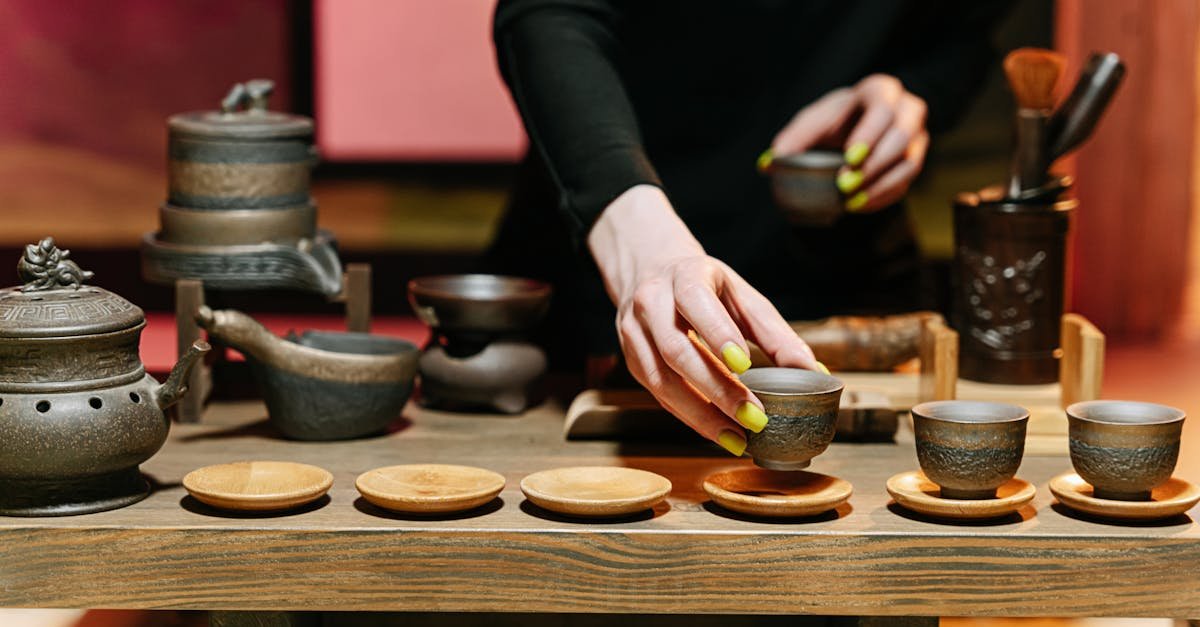If you’ve ever sipped tea from a Yixing teapot, you’ve experienced more than just a drink—you’ve touched a piece of history. These teapots, originating from China’s Yixing region, have been cherished for centuries for their unique blend of artistry and functionality. Their story stretches back over 600 years to the Ming Dynasty, when skilled artisans began crafting these remarkable vessels to meet the growing demand for tea.
What makes Yixing teapots so special isn’t just their rich history but the meticulous craftsmanship behind each one. Handmade using specialized tools and techniques, these teapots are true works of art, often adorned with intricate designs inspired by nature. Beyond their beauty, they’re prized for enhancing the flavor and aroma of tea, making them a favorite among tea enthusiasts worldwide.
Dive into the fascinating journey of Yixing teapots and discover the artistry that keeps this tradition alive.
Introduction to Yixing Teapots
Yixing teapots blend simplicity and elegance with unparalleled craftsmanship. These teapots have been an integral part of tea culture for centuries, combining functionality with artistic expression.
Definition and Origin
Yixing teapots are traditional Chinese teapots crafted from zisha clay, a natural material found in Yixing, Jiangsu Province. These teapots trace their origins to the 16th century during the Ming Dynasty. The fine-grained clay, available in purple, red, and yellow hues, became the primary medium for creating these timeless pieces.
Unique Properties and Cultural Importance
The porous structure of zisha clay uniquely distinguishes Yixing teapots. This feature allows the clay to absorb and retain the flavors and aromas of brewed tea over time, enriching each brewing experience. In Chinese tea culture, these teapots symbolize a return to natural simplicity and are cherished for their artistic beauty and functionality.
History of Yixing Teapots
Yixing teapots have a legacy spanning over 600 years, rooted in China’s Yixing region. These teapots evolved through centuries of innovation, influenced by culture, artistry, and global interactions.
Origins in the 16th Century
The first Yixing teapots emerged during the early 16th century under the reign of Emperor Zhengde (1506-1521). Monks from the Jinsha Temple crafted these teapots from the region’s unique zisha clay, showcasing both utility and artistry. Gong Chun, a servant to the scholar Wu Lun, is often credited with popularizing these teapots. His creations resonated with scholars due to their elegant simplicity and practical design.
Development during the Ming and Qing Dynasties
During the Ming Dynasty, Yixing teapots gained popularity for brewing loose-leaf tea, which became a widespread practice. The porous zisha clay enhanced tea’s flavor, making these teapots favored by intellectuals and tea connoisseurs alike. In the Qing Dynasty, artisans like Chen Mingyuan and Shi Dabin refined the form and aesthetics of these teapots. Chen Mingyuan’s designs, featuring intricate relief patterns and calligraphy, exemplified a blend of sophistication and functionality. The period also witnessed the production of innovative shapes and artistic designs that catered to both local and export markets.
Influence on European Pottery
By the 17th century, Yixing teapots reached Europe, transported along trade routes. Their distinctive craftsmanship inspired potters in countries like the Netherlands and England, who attempted to replicate their design and finish. These exported teapots often featured larger sizes and elaborate patterns, aligning with European tastes. Yixing teapots directly influenced the development of European ceramics, serving as prototypes for many early teapot designs.
Modern Era
Today, Yixing teapots are primarily crafted in Dingshan, the town at the heart of their tradition. The establishment of Yixing Zisha Factory Number 1 in 1958 standardized production, preserving traditional techniques. Modern masters, such as Xu Xiutang and Zhou Guizhen, continue to honor and refine this art, blending heritage with contemporary styles. The Yixing region has become a popular tourist destination, attracting tea enthusiasts and collectors who appreciate the storied craftsmanship of these teapots.
Table: Key Historical Milestones of Yixing Teapots
| Period | Event | Significance |
|---|---|---|
| Song Dynasty (10th) | Early use of zisha clay for utensils | Laid foundation for teapot production. |
| Ming Dynasty (16th) | First teapots by Jinsha Temple monks | Marked origin, popularized by Gong Chun. |
| Qing Dynasty | Favored by scholars, notable potters emerged | Enhanced artistic and cultural value. |
| 17th Century | Exported to Europe | Influenced European pottery, global spread. |
| 1958 | Yixing Zisha Factory Number 1 established | Ensured modern production and tradition. |
Craftsmanship of Yixing Teapots
Yixing teapots are celebrated for their meticulous craftsmanship, blending traditional methods with creative artistry. Each handmade teapot reflects both skill and heritage, ensuring every piece is unique in design and function.
Materials
Yixing teapots are crafted from zisha clay, primarily available in purple, red, and beige hues. The rare Tianqing clay is also highly valued for its exceptional permeability. This clay is sourced from Yixing’s rich mines and possesses high plasticity, making it ideal for intricate hand-shaping. Its fine-grained texture facilitates detailed designs while maintaining durability.
Preparation of Clay
Artisans source the clay from geological deposits over 350 million years old. The raw material undergoes natural weathering or mechanical processing to enhance its quality. After mining, the clay is ground, iron particles are removed, and it is sifted to ensure a pure base. Water tempering follows to achieve the right consistency for shaping.
Shaping the Teapot
The shaping process relies on precise hand tools made from wood and bamboo. Artisans craft each teapot’s components, such as the body, spout, handle, and lid, separately before assembling them. Handmade designs, especially those with complex details, are labor-intensive, while more affordable teapots may use slipcasting. Clay shrinks by about 10% during firing, so artisans account for this in their measurements.
Firing
Teapots are fired at temperatures ranging from 1100°C to 1180°C. This firing not only hardens the clay but also creates its porous surface, which interacts with tea to enrich its flavor over time. Proper firing ensures structural integrity and enhances the teapot’s aesthetic.
Finishing
Yixing teapots remain unglazed, allowing the natural hues and textures of the clay to shine. The presence of ferric oxide and micro-metals gives the surface a smooth, earthy finish, which deepens in color with use, adding to its visual appeal and uniqueness.
Designs and Styles
Yixing teapot designs include geometric shapes like round, square, and cylindrical forms that symbolize harmony and balance. Naturalistic styles draw inspiration from objects such as pumpkins or persimmons, showcasing the artisan’s creativity. These designs incorporate elements from nature, literature, and mythology, blending functionality with visual artistry.
Table: Craftsmanship Process Overview
| Stage | Description | Key Detail |
|---|---|---|
| Materials | Zisha clay (purple, red, beige) from Yixing mines | High plasticity, ideal for hand-shaping. |
| Preparation | Weathering, grinding, iron removal, sifting, tempering | Ensures consistency, higher quality pounded weeks. |
| Shaping | Hand-shaped with tools, parts assembled | Expensive hand-crafted, cheaper slipcast. |
| Firing | 1100-1180°C, creates porous surface | Enhances tea flavor absorption. |
| Finishing | Unglazed, natural color preserved | Reflects simplicity, aesthetic value. |
Conclusion
Exploring the world of Yixing teapots offers you a glimpse into a tradition where art meets functionality. These teapots aren’t just vessels for tea; they’re a celebration of history, culture, and meticulous craftsmanship. Each one carries the legacy of skilled artisans and the natural beauty of zisha clay, making every cup of tea an experience to treasure.
Whether you’re a tea enthusiast, a collector, or someone who appreciates fine artistry, Yixing teapots invite you to connect with a timeless tradition. Their unique charm and ability to enhance tea’s flavor ensure they remain a cherished part of tea culture for generations to come.
Frequently Asked Questions
What is a Yixing teapot?
A Yixing teapot is a traditional Chinese teapot made from zisha clay, a unique material found in the Yixing region. Known for their porous surface and fine craftsmanship, these teapots enhance the flavor and aroma of tea over time, making them a favorite among tea enthusiasts.
What makes Yixing teapots unique?
Yixing teapots are crafted from porous zisha clay, allowing them to absorb the flavors and aromas of tea brewed within. Over time, this enhances the tea’s richness, creating a personalized brewing experience while showcasing artistic designs and natural simplicity.
Why are Yixing teapots considered valuable?
Yixing teapots are valuable due to their meticulous handmade craftsmanship, unique zisha clay material, and long-standing cultural history. They are also prized for their ability to improve the flavor of tea with continued use, making them both functional and collectible.
How are Yixing teapots made?
Yixing teapots are handcrafted using zisha clay, which is shaped, assembled, and fired at high temperatures. This process creates their signature unglazed, porous surface that retains tea flavors. Artisans often incorporate intricate designs, blending artistry with functionality.
What types of clay are used in Yixing teapots?
Yixing teapots are made from zisha clay, which includes purple, red, and beige hues. Rare types, like Tianqing clay, are highly valued for their permeability and aesthetic qualities. The clay’s natural texture enhances the teapot’s beauty and performance.
How does a Yixing teapot enhance tea flavor?
The porous surface of zisha clay absorbs the oils and flavors of tea brewed inside. Over time, this retained essence blends with new brews, enhancing the flavor complexity and making each subsequent cup of tea richer.
Are Yixing teapots suitable for all types of tea?
Yixing teapots are ideal for one type of tea per teapot due to their flavor-absorbing properties. For example, dedicate separate teapots to green, oolong, or black tea to prevent flavor mixing and fully enjoy each tea’s unique essence.
How should I care for a Yixing teapot?
To care for a Yixing teapot, rinse it with warm water after use and avoid detergents, as the porous clay can absorb chemicals. Dry the teapot thoroughly and store it in a clean, dry place to preserve its integrity.
Can I use a Yixing teapot for Western-style tea brewing?
Yixing teapots are primarily designed for traditional Chinese tea brewing, particularly for loose-leaf teas. While they can be used for Western-style brewing, their small size and unique features are better suited for multiple short infusions.
Are Yixing teapots still handcrafted today?
Yes, traditional Yixing teapots are still handcrafted by skilled artisans in the Yixing region. Modern techniques have also been introduced, but many craftsmen prioritize preserving the traditional methods that have been passed down for centuries.


